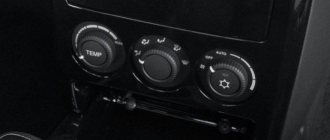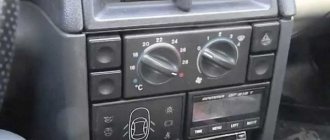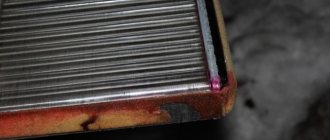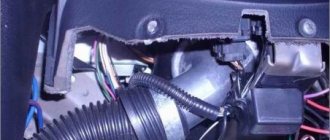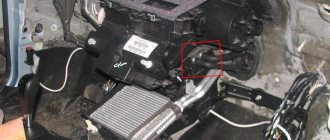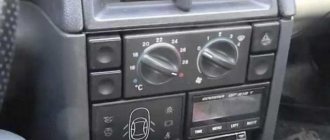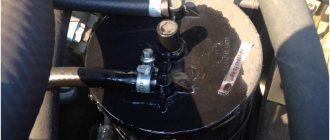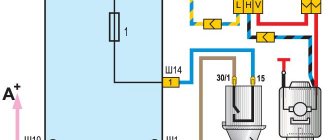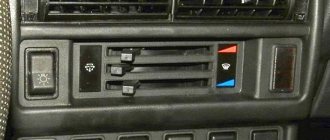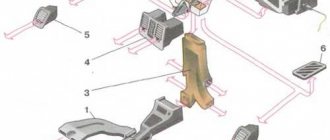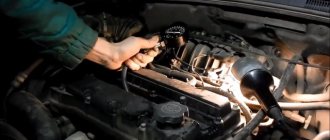The Lada Priora is in many ways similar to its progenitor, the VAZ of the tenth family, including the design of the heater. The manufacturer decided to leave the operating principle of the stove, replacing only some elements with new ones. At the same time, Lada Priora also inherited familiar problems, for example, when the stove does not heat and blows cold air.
Preparatory stage
Troubleshooting the heater should begin provided that the power unit and engine cooling system are in order to eliminate their influence. To do this, you need to make sure that the antifreeze is poured in the proper amount, the engine is in good condition and is functioning normally. And after that, find out why the stove on the Priora does not work. First, check the coolant level in the expansion tank. Next, you need to start the engine and warm it up to operating temperature. After this, you need to check the serviceability of the thermostat - feel the thick hoses that go from it to the car radiator.
The top one should gradually become hot. If the rubber hose is still cold, the thermostat is faulty. In this case, you can continue working only after replacing this element. Fortunately, its cost is low.
Another reason why the engine may not warm up to operating temperature is a leaky expansion tank cap. It should keep excess pressure in the system. Often, simply replacing this cover can completely eliminate the problem.
On the Priora, unlike the Tens, the cooling system is organized differently. And the formation of an air lock there is practically excluded. It can occur when the system is leaking or when antifreeze is poured into a completely empty expansion tank. This can be fixed quite simply. You need to drive your front wheels up some hill in a warm car and vigorously apply the gas in place. The expansion tank cap should be removed.
Engine cooling system malfunction
If the motorist suspects that the problem lies precisely in the cooling system of the power unit, you should make sure that the level of coolant, which is located in the expansion tank, is in the middle of critical values. In other words, there should be enough antifreeze in the tank so that it is not below o and above “max”. Otherwise, the car owner will have to monitor the condition of the coolant; if it has to be topped up periodically, it is quite possible that there is a hole in the cooling system and it is leaking. Before changing any components, you need to check all the pipes, which will allow you to find leaks. In addition, it would be useful to tighten the clamps. There is one trick that many Lada Priora owners use: in winter, antifreeze is poured into the tank only up to about 0, which allows you to quickly warm up the interior. The fact is that a smaller amount of liquid in the device contributes to its rapid heating.
Heater radiator malfunctions
Another reason why the heater in a Lada Priora car does not work (cold air blows from the deflectors) may be the accumulation of dirt in the heat exchanger. When the cooling system operates, deposits accumulate in the engine block itself over time, which are then spread throughout the entire system, including into the heater radiator. These deposits prevent it from working effectively. The system will heat the air worse. In this case, the heater radiator can be replaced entirely. It is removed from the engine side. Before starting work, be sure to drain the antifreeze from the cooling system. Then dismantle the windshield wiper arms, the frill trim and move aside part of the soundproofing shield. After this, disassemble the stove body, disconnect the wires, remove the fan motor along with the impeller and remove the heat exchanger, disconnecting the supply hoses from it.
Repair of devices on Lada Priora
As practice shows, it is more difficult to get to repairing a gearmotor; more precisely, it is more difficult to perform, since it is practically impossible. But, if a motorist wants to leave his Priora with the same heater element, he should carefully bend the pressed side, then remove the gear motor cover.
It is extremely important to pay close attention to the commutator, brushes and bearings. If possible, you can replace directly non-functioning parts. Then the bearings should be lubricated; silicone grease is best suited for this, as it can have a beneficial effect on the service life of all elements of the system.
After the damper is repaired, if it works with defects, you will have to check the functionality of the entire system; if it does not work properly, the driver will have to replace the gearmotor.
Problems with the damper gear motor or fan motor
A common malfunction on a Lada Priora car is that the heater does not work. No air blowing at all.
First, you should make sure that the heater motor is working - at least cold air should be blowing from the deflectors. If not, then you need to check the integrity of fuse F9.
If it is intact, it means the stove fan is not working. "Priora" is equipped with a "ten" fan. Therefore, removing it exactly repeats the procedure on the “ten”. In some cases, the fan does not spin because leaves or other foreign objects have gotten between the impeller and its housing, which can block rotation. In this case, you can hear a characteristic hum.
Cold air can also come out of the deflectors because the gear motor that controls the damper that blocks the flow of hot air is not working. It is also accessible from under the hood.
Often the cause of gearmotor failure is oxidation of conductive contacts. They need to be cleaned with sandpaper by disassembling the body. You should also pay attention to the strength of the air flow. If even at maximum speed the air is blowing weakly, it may be a clogged cabin filter. It is located under the hood in the heater housing and creates additional interference.
Clogged filter
Experienced Prior owners have developed an algorithm of actions to find out where the heating system is leaking.
First approach
Before all checks, you need to make sure that the fan is working - it would be unreasonable to go deeper if the main element does not spin. The next steps are as follows.
- The engine heats up to the desired temperature;
- The pipes leading to the heater are probed. Both are hot - okay, one is at ambient temperature - which means there is no filler circulation;
- The hood opens, the tap is located and turns to another position. If it gets stuck, you will have to immediately soak it with WD-40.
- The system is checked for leaks. The detected ones are eliminated: a constant lack of coolant is also the cause of cold airflow;
- The tap is working, there is no leak - the plug is removed from the tank and the liquid level is checked. Often an air lock forms in the tank; in this case, the coolant is topped up to normal, and the gas pedal is pressed sharply several times. The fluid circulation will resume and squeeze the plug out of the reservoir;
- To make the last step more effective, it is better to drive the front end onto the nearest hillock so that the car’s radiator is lower than the stove radiator.
Second approach
When (or if) both pipes are filled with hot liquid, we move on to the dampers.
- Again you will have to climb under the hood, this time to observe the operation of the damper;
- If it is warped or jammed, you can try to gently shake it with your hand from inside the cabin. To do this, remove the central deflector and unscrew the plastic guides to reach the stuck element. Access is only possible for a thin limb, so it is advisable to invite a female person to the procedure if she does not mind;
- If there are serious problems with the damper (the fastenings have rusted, the plastic has warped due to temperature or it has cracked), alas, you will be faced with difficult work: you will have to disassemble half of the heating system.
Third approach
The microreducer is a complete headache. First, its status is checked:
- The left handle is moved to the “min” position. After a 15-second wait, the engine starts;
- The controller that monitors the self-propelled guns is disconnected;
- The tester measures readings
on both contacts. The resistance should be 800-1200 Ohms for units 1303.3854; 1313.3854 and 1333.3854; for controller 1323.3854 the norm is 3600-5000; - The same operation is carried out in the “max” position. Now the data is in the range of 3200-3500 for the first group and 1200-1600 for 1323.3854;
- If there is no resistance or its unchangeability, the track on the sensor has been erased. It is not sold separately, so you will have to change the entire MMR. It is clear that not all the reasons why the stove does not work and cold air blows on a Priora can be eliminated on your own.
However, by following the above recommendations, you will at least understand what is preventing you from driving comfortably. And also estimate upcoming expenses. For example, if you have to change the entire SAUO unit, you will have to pay about 1.5 thousand rubles for it. plus the work of an electrician.
Incorrect operation of the cabin temperature sensor
There is another reason why the stove on the Priora does not work correctly. It occurs due to a malfunction of the cabin temperature sensor. It is located in the ceiling lamp.
The element, measuring the air temperature in the cabin, gives a command to the damper gearbox to open or close. This way the microclimate in the cabin is regulated. Its serviceability should also be checked.
Operating principle of the stove
The heater is controlled by a controller, from which a signal is received to turn on the stove.
The driver sets the temperature in the cabin. If the temperature sensor detects that the temperature has dropped below the set level, the controller sends a signal to change the opening width of the stove damper. In some cases, an electronic failure occurs; instead of hot air, cold air is supplied. The controller also regulates the number of fan revolutions. It sends a signal to an additional resistor, which, in turn, adjusts the operation of the fan using the built-in resistance. The resistor may not be used at all - then the fan runs at maximum speed. Thus, it acts as a “brake” for this node. If the resistor breaks, the fan may not start at all.
The driver can control which direction the air flow will be directed. To do this, he needs to set the value on the dashboard. The control regulators bark a command to move the dampers.
Malfunctions of the heater control unit
The operation of the heating system is completely dependent on the heater control unit. It distributes air flows, the intensity of airflow to different zones of the cabin and the temperature regime. If it fails, the stove naturally stops working.
There may be malfunctions of the switches (“twisters”). The malfunction of the control unit should be checked last, since this unit is electronic and can rarely be repaired. Therefore, to check it, it is advisable to temporarily replace it with one that is known to work, borrowing it from a friend or in a store with a deposit.
Features of the heater in a Priora with air conditioning
A common reason why the stove (Priora with air conditioning) does not work is the failure of the speed control unit (RFV), which is located on the heater housing under the hood. It regulates the intensity of the fan motor. If it fails, the stove stops functioning altogether or operates only at fourth speed.
The cause of the malfunction is often prolonged operation of the heater in recirculation mode (with the air damper closed) and, as a consequence, its overheating. Therefore, its performance should also be checked.
Problems with Priora heater elements?
The stove on the Priora does not heat up and the cooling system is working properly? Then you should first understand the principle of its operation:
The heater control unit (HCU) receives a signal from the interior temperature sensor (installed in the interior lamp) and compares it with the temperature set by the driver. If the difference is greater than a certain value (for example, more than 2 degrees), then the ACS unit sends a control signal to the heater damper motor (MMR), which controls the heater dampers (opens or closes the air supply from the heater radiator).
If the heater only blows cold or hot air, regardless of the regulator (knobs) on the heater unit, this means the heater dampers are not working and there may be several reasons for this. Start by checking the overhead interior temperature sensor.
Thus, we have examined all the elements of the heater (see also “design of the Priora stove”). Start following the order of the article, moving from simple to complex, and then you will certainly be able to repair the Priora heater yourself.
Possible reasons for cold air supply
A common situation is when cold air blows from the Priora stove; there may be more than one reason for this. It is in identifying the malfunction that the main problem lies. There may be several reasons why the stove on a Priora does not blow:
- A breakdown of the engine cooling system is the most common problem. This is where diagnostics should begin. In most cases, the stove on a Priora does not turn on precisely for this reason.
- A heavily dirty cabin filter that should be replaced with a new one. This procedure should be performed every six months, without waiting for the moment when the stove starts blowing cold air.
- The stove on the Priora is not blowing well, possibly due to the damper, which may be stuck. It may not open completely, thus blocking the path of hot air flows.
- The problem may also lie in the gearmotor. It is necessary to check its functionality.
- If the stove on a Priora does not work as you would like, then you should pay attention to the control unit.
- The temperature sensor can also have a negative impact on the performance of the heating system. To determine this point, you will need to turn off the sensor and see how the heater behaves.
Carrying out diagnostics and repairs: where to start
Let's deal with the most difficult case when the stove does not start.
First, you need to check the engine cooling system, because malfunctions may be associated with it. Check the amount of fluid in the expansion tank. Its level should be between the minimum and maximum marks. If you constantly add fluid to the reservoir, it is necessary to eliminate the leak in the cooling system. Check the pipes and tighten the clamps. In winter, you can only fill in a minimum amount of liquid, so it will heat up faster and warm air will flow into the cabin. Check fluid circulation. It may be insufficient if the pump breaks down or the cooling system is clogged. The thermostat is checked with the engine warmed up to 75 degrees. If the radiator pipe is cold when the engine is hot, then the liquid circulates in a small circle. Replacing the thermostat can help with this breakdown. If the heater works, but blows cold, then the problem may be the formation of an air lock in the engine cooling system.
If the fan works, but pumps air very poorly or weakly, then start diagnosing by checking the cabin filter. It may be contaminated, resulting in insufficient air in the system. Failure is usually preceded by the appearance of an unpleasant smell of dust.
If there is no air flow, you must:
- Check the 25 A fuse.
- If the fuse is intact, then check the fan itself. It may have malfunctioned. This element cannot be repaired, only changed entirely. It also changes when a whistle or buzz appears.
- Sometimes there may be no air flow at only one of the speeds, for example, the first three or fourth. In this case, replace the resistor, it is the one that supplies the resistance incorrectly and stops the fan from working.
- Check the heater control unit. If all other parts are working, then the problem may be in it or in the temperature sensor located in the cabin.
We carry out comprehensive diagnostics
Removing a faulty heater from a Lada Priora is not so easy. Even experienced motorists cannot cope with this task quickly. To avoid doing such a large amount of work in vain, it is better to first diagnose the heating system. You must proceed as follows:
- We probe the channels through which the coolant flows to the heater. They should be warm when the stove is on. In addition, when pressing on the main rubber hoses, resistance should be felt. If resistance is not felt, the pump pump may be faulty. This mechanism is responsible for creating the pressure of fluid flows necessary for normal operation of the heater.
- A little secret that may be useful to Lada Priora owners: does the stove blow cold air for a long time and does not warm up as quickly as we would like? Then you can try filling coolant to the bottom mark in the tank. In this case, the liquid will warm up faster. If you practice this method, you will need to constantly check the coolant level.
- If a running heater is a source of noise, then we can talk about a problem in the bearing, which is located on the electric fan. This situation cannot be ignored, since in the future the fan may jam and repairs will take place on a much larger scale.
- Is the stove not working? Perhaps the problem is hidden in fuse F9 with a rating of 25 A. Its function is to protect the power electrical lines of the heater. A blown fuse must be replaced. If such a situation occurs with enviable consistency, then it is necessary to check all electrical circuits of the heater, the insulation of the windings on the fan and the presence of an overload in the power circuit.
Repairing fan and radiator
Often the heater regulator on a Priora does not work due to the fact that a large amount of dust or other small dirt particles has entered the heat exchanger. Over time, contaminants get inside heating devices. This cannot but affect the performance of the entire system. Air masses do not warm up well. You may note that the oven only works in position 4. In case of contamination, you can simply. You need to remove the device from the power unit side. Do not forget to first drain the antifreeze from the cooling system, disconnect the windshield wipers and wires, dismantle the fan completely and remove the entire radiator by removing the pipes leading to it.
There is not only the problem that the Priora stove operates only at maximum, but also the complete absence of air jets from the heating system. The first step is to make sure that the radiator is working in principle. Place your hand and note whether any streams of air are blown out. Even cold air masses indicate that the system is operating. Otherwise, there is a possibility of fuse failure.
If the fuse stops, it means the furnace fan is broken. One possible reason for the fan not spinning could be small leaves or other small objects that have gotten into the fan. This will be confirmed by a hum. If necessary, you can remove the fan on the Lada Priora using the same procedure as on the tenth model. Replacing the fan will solve the problem.
On Lada Priora, the damper may not work, which will prevent hot air jets from entering the cabin. You can get to the gearmotor through the hood. If the problem is not with the damper, then most likely the stove is not working due to the contacts being oxidized. Simply clean them with sandpaper.
No heating at idle
It is not for nothing that this issue has been submitted for separate consideration, since it worries many motorists and solving the problem can be much more difficult than one might expect. So, you have a Priora, the heater does not heat up at idle, although when the car is moving, the interior is heated in normal mode. Here you can also identify several possible reasons:
- Insufficient coolant level.
- Leaks that lead to a decrease in antifreeze levels.
- There is an air lock in the system.
The stove on the Priora does not turn on
Solving the problem of poor heating by the stove on the Lada Priora
If the stove in the car does not heat well (we are most interested in the Priora at this moment), then this situation causes a lot of inconvenience to the driver and passengers.
In the summer, this problem is not relevant, because no one really worries about the condition of the heater.
And only with the onset of cold weather does the overwhelming number of motorists become puzzled by the problem of a non-working heating system.
Why doesn't the heater work on the Lada Priora?
The Lada Priora is in many ways similar to its progenitor, the VAZ of the tenth family, including the design of the heater.
The manufacturer decided to leave the operating principle of the stove, replacing only some elements with new ones. At the same time, Lada Priora also inherited familiar problems, for example, when the stove does not heat and blows cold air. Heater assembly (2170-8101012 or 2111-8101012-10).
Air flow distribution gearmotor (2170-8127100).
The stove does not work on the Lada Kalina (reasons and repairs)
Most owners of Lada Kalina cars, who have previously encountered other VAZ models, note that its stove heats much better compared to its predecessors. Unfortunately, it sometimes breaks.
In this article, we will try to figure out why the Lada Kalina stove does not work (reasons and repairs).
The most common cause of malfunction of the Lada Kalina heating system is problems with the engine cooling system.
Repair of the VAZ 2110 stove control unit
The SAUO receives information from:
- – cabin air temperature sensor (No. 6), which has a built-in small-sized fan.
- – MMR (micromotor reducer) (No. 9), information about the position of the heater damper.
Damper control.
Based on the information received and the set air temperature, the controller controls the position of the heater damper, sending appropriate signals to the damper drive micromotor.
Fan speed control.
The stove doesn't heat.
Either the radiator is clogged or something, I don’t know.
First, I changed the thermostat. Then people advised to install email. pump for the gazelle stove. Well, I bought this miracle (650 rubles), installed it in front of the stove and powered it for ignition.
I mean, I went. It's so crazy warm in the car that you can't even breathe.
When the heater is turned off, the fan comes on if there is a traffic jam. Question: Who did this, what difficulties did they encounter, what is the risk of it all?
The stove does not heat, six main reasons
Today a very relevant article (especially in winter) is that the car’s heater does not heat, or heats very poorly!
Why does this happen and what are the main reasons for this?
After all, a normal working car should warm up the interior within 10 - 15 minutes (unless, of course, you have a turbocharged engine, there is a partial solution for that here). If after 15 minutes you have barely warm air (or not at all), and all the glass inside is frozen, then this is not “good”! Read my tips below... First, let's think about how a car warms up?
As we all know, during operation the internal combustion engine heats up very much, this happens from the friction of the pistons against the cylinder walls, as well as from the combustion of the fuel mixture.
Hi all! I went to a friend’s car service center and they determined that the engine itself was not working. The price of a new one is 1500 rubles. I have a Conder Halla. When removing, the condenser tubes, the cup or whatever it is called, or where the support is attached, get in the way.
Thanks to the designers of AvtoVAZ!
Dima. Panasonic has the same canoe) there is information on the Internet on how to do this from Panasonic without disassembling the entire heater, it turns out that you cut the casing in the engine compartment and on the motor itself, which does not violate the integrity of the structure and serves more as a boot)) it can be attached back without problems))
How to repair the heater mode switch in Lada Priora
Lada Priora is a product of the domestic automobile industry.
This car has earned people's love for its low cost, good quality, and the availability of parts when repairs are needed. Despite good reviews from owners, the car is not without a number of shortcomings.
For example, it happens that the Priora stove only works at speed 4. You can go to a service station to find out why the Priora stove switch is not working.
Assessing the reasons or why the heater may stop blowing warm air
As it turns out, even a lack of antifreeze in the tank causes the engine to heat up and the heater to blow cold air from all the grilles. More trivia:
- The damper that determines the path of outside air entering the cabin is jammed.
- The stove faucet does not work.
- The heater radiator is clogged.
Serious reasons are associated with problems in the engine cooling system:
- The thermostat is stuck.
- The pump failed.
- The cylinder head gasket is broken.
The nodes may be fine, but unnoticeable accumulations of air in a small or large circuit can shape the weather. In the automotive environment, they are called air jams, and the process itself is airing.
The main problems with the heating system on Priora
Why doesn’t the stove heat up if everything is fine with the cooling system? First, it’s worth understanding how exactly the stove in a car works.
The temperature sensor in the cabin receives a signal from the heater control unit. Then the controller begins to compare the cabin temperature with the one set on the sensor by the driver. If there is a difference, the controller sends a signal to the heater gear motor located under the hood, and it, in turn, controls the operation of the damper and, depending on the signal, will open or close the air supply from the radiator.
If, regardless of whether the air regulator switches or not, only cold or hot air continues to blow into the cabin, it means that the control flaps are stuck in one position. In 17% of cases this is a breakdown of the heater in the car. There may be several reasons:
- The temperature sensor located on the ceiling in the cabin is broken.
- The damper micromotor is faulty, the gear teeth are worn out or the resistor layer is worn out.
- Clogged cabin filter.
- A complete lack of flow indicates a broken heater fuse.
The next part to check if all of the above is ok is the fan. It may need to be replaced. If the stove makes humming or whistling sounds when operating, this is also a sign of a fan malfunction.
The next point to check is the heating resistor; its main function is to switch fan speeds.
If everything is fine with the dampers, but cold air continues to blow into the cabin, the radiator may be clogged. When the check of each described part is completed, but the problem remains, you should examine the controller itself for controlling the operation of the stove.
But before you buy a new device, check the functionality of the old one. Just replace it with another controller that you can borrow from a friend. Perhaps the problem with the poor performance of the stove is something else.
What to do first
In order not to get buried in the abundance of reasons, it is necessary to act from simple to complex. Leave the frightening thoughts of a broken cylinder head gasket and take a trifling attitude, as if the electric damper actuator has failed. Actually, that's where we'll start.
Check the operation of the climate control shutters
Turn the knob or rocker of the climate system and evaluate the temperature of the incoming air. For example, with “blue all the way” the air should be noticeably cold, and with the maximum red settings it should be warmer.
Immobilized valves will not be able to mix flows according to the specified °C value. Therefore, at any position of the regulator, air will blow at the same temperature. The dampers stop as a result of damaged fasteners or a failed servomotor.
Attention. If the cooling system has a tap installed on the stove, check its position. Must be open.
Is the antifreeze level in the expansion tank stable?
Lift the hood, find the “extender” and the boundary marks on it. When cold, the antifreeze level should be between the MIN and MAX marks. If the tank is constantly emptying, look for leaks. You can look at where the coolant goes using the Lada Vesta as an example.
Heater radiators of some cars, for example Lada Kalina, are very sensitive to the amount of antifreeze in the expansion tank. At the slightest leak, the engine heats up, and the stove is cold or barely warm. And in general, when liquid flows out, air comes in and thus the system becomes airy.
Advice. It is better to look for small leaks under pressure. For example, adapt a regular spool valve from the chamber to the “expander” and create pressure in the tank with a bicycle pump.
Inspect the heater radiator for unobstructed circulation
Find two pipes going to the heater heat exchanger near the engine shield and touch them. The radiator assembly is embedded in a small circle in parallel, which means that the hoses should warm up immediately after starting the engine. It is better to carry out work when the engine is warmed up.
If one of the tubes is cold and the other is warm, the radiator is clogged or airy. First, rule out the presence of a dirt plug: pull off the outlet hose and evaluate the flow - practically nothing will flow out of a clogged radiator installation. Isn't that the point? Then feel free to expel the air.
How to remove an air lock without draining the coolant
It happens that if there is air in a small circuit, the temperature sensor on the dashboard behaves strangely: the needle sometimes jumps. For example, it was at 60°C and instantly became 90-100°C, then returned back. This is explained by the fact that the air heats up noticeably faster than the liquid and to higher temperatures. As a rule, the needle twitches when the system is seriously aired.
Features of the Priora stove
The climate control of this car on some versions is designed for the installation of air conditioning. Therefore, the design of this device in this case is slightly different than that of the VAZ-2110 heater. This article discusses the standard heater option. Although they have a lot in common. The Priora stove (heater without air conditioning) includes the following large components:
- Stove body.
- Air duct system.
- Heater electronic control unit (ECU) with control console.
These are, so to speak, three basic nodes. All of them, except the ECU, are disassembled and consist of various subsystems. To be honest, the control unit can also be disassembled if desired. But you shouldn't do this. This is a delicate electronic device and can only be repaired by a specialist. But with the other two there are options.
Frame
After the control unit, the stove body is the most complex object. The fact is that it includes several elements:
- Housing consisting of two parts.
- Blower electric motor with fan.
- Small heating radiator with pipes.
- Variable resistor.
- Heater air damper.
- Micromotor gearbox, heater damper drive.
- Cabin filter.
All of the listed elements sometimes fail, and it is quite possible to replace them yourself, without resorting to the services of a specialist.
Location and access
As on the VAZ 2110 model and modifications, the heater is located outside the passenger compartment. It is located in the engine compartment. Right under the windshield. It is separated from the engine by a special fabric and cardboard partition. And the top is covered with a plastic double casing, which hides this compartment, in which, in addition to the heater, a brake vacuum and a windshield wiper drive are also installed.
To gain access to the Priora stove, these elements must be dismantled. Disconnect the cooling system hoses. Unscrew the 3 fastening nuts and remove the housing. This process is described many times and shown in the attached video. Therefore it is not worth repeating here.
Cabin filter
Most often, it is this part that fails or exhausts its resource. It simply gets clogged with dirt and dust. This is expressed in a decrease in the intensity of fan operation. Sometimes, it becomes so dirty that the heater fuse blows. The load on the electric motor increases so much that the fuse simply blows. The purifier is located at the air inlet into the heater. Near the right wing of the car. It is closed with a decorative plastic cover.
Electric stove motor
To remove and replace the electric motor of the stove, on a Priora without air conditioning, you have to completely dismantle the heater. Or at least push it forward a little. The fact is that this motor is located on top of the Priora stove and is located under the supporting part of the windshield.
Heater resistor
This element serves as a kind of fan rotation speed switch. It has several resistance levels. Each step is speed. A faulty resistor is easy to determine. If none of the speeds except the maximum one work, then in 99 cases out of 100, it is the resistor. And only 1 switch, in the control unit.
It is also located at the top. But it can be easily removed without dismantling the entire stove. It is enough to remove the connector and unscrew 1 screw fixing the resistor. That's all.
Micromotor gearbox
In the Priora climate control system, there is no option to disconnect the radiator from the car’s cooling system. That is, the hot liquid constantly circulates in it. The supply of cold air is ensured by directing the air flow from the fan using a special damper that blocks the radiator and allows the flow to pass by.
This part is moved by a special device - a micromotor-reducer. It is controlled by the control unit. It can also be replaced without completely removing the heater. Although it is located between the vacuum brake booster and the heater housing. However, its diagnosis and replacement has features that will be described in a separate topic.
Heater air damper
One of the key devices of the system, despite its simplicity. The damper moves on an axis rotated by a micromotor gearbox. Located inside the Priora stove. Therefore, to repair or replace, naturally, the stove must be dismantled.
However, if you still have a Priora with a plastic flap, then the drive protrusion on it may break off. This is quite easy to determine. Turn on the ignition, and having removed the casing separating the niche with the heater from the engine compartment, observe the gearbox, switching the flow temperature control handle from hot to cold. You can see that the drive rod rotates, but the temperature does not change. This means the damper needs to be replaced. There will be a separate article about this procedure.
Radiator
And the main heating unit is the stove radiator. It is also located on the right side, near the damper drive. Naturally, to replace it, the Priora stove will have to be removed. It is attached to the body with three self-tapping screws. And after removing the heater, it is easy to pull it out by unscrewing these screws. Clean the radiator seat and install a new one. This part is made of plastic and aluminum and cannot be repaired. Replacement only.
Determining a radiator leak is quite simple. Although on these heaters the coolant does not enter the cabin when there is a leak from the radiator, but when it appears, in any position of the damper, the evaporation immediately falls on the windshield. They form a clearly visible cloudy film with a pungent odor of antifreeze. This is a clear signal to replace the heater radiator.
Electronic heater control unit
This is a mini-computer with its own program. The convenience is that it is initially connected to the computer diagnostics channel. Therefore, many faults can be identified by connecting diagnostics to the Priora diagnostic connector. But this interesting topic will be described in a separate article.
Useful video on the topic “Removing the Priora stove”:
